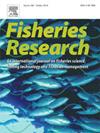Predator responses in recreational fishing: Assessing selective pressure of bait types on behavioral diversity in northern pike (Esox lucius)
IF 2.3
2区 农林科学
Q2 FISHERIES
引用次数: 0
Abstract
This study investigated the predatory behavior of northern pike in response to trolling with natural and artificial baits using underwater cameras. Predator types of 32 captured pike were identified based on their coping style under altered environmental conditions by measuring latency to forage in individual novel net enclosures. Fast-attacking pike during angling were more likely to forage in the enclosures than slow-attacking conspecifics. Bait type influenced attack latency, with soft plastic baits being attacked faster than natural baits. Pike biting the artificial bait exhibited a faster defensive response compared to the natural bait; however, the likelihood of capture was not affected. The results suggest that wild pike exhibit variability in coping styles, i.e. different responses to environmental changes, which are related to their vulnerability to angling. In consequence, bait selectivity, due to more proactive predators attacking soft plastic baits less hesitantly than their reactive counterparts, may influence pike populations even within the same fishing technique. Recreational fishery management should consider the behavioral diversity within pike populations to maintain genetic integrity and contribute to both angler satisfaction and ecosystem function.
休闲垂钓中捕食者的反应:评估诱饵类型对北方梭子鱼行为多样性的选择压力(Esox lucius)
本研究利用水下摄像机调查了北梭子鱼对自然和人工诱饵的捕食行为。通过测量捕获的32只梭子鱼在不同环境条件下的觅食潜伏期,确定了它们的捕食者类型。在钓鱼时,快速攻击的梭子鱼比缓慢攻击的同类鱼更有可能在围场中觅食。饵料类型影响攻击延迟,软塑料饵料比天然饵料受到攻击的速度更快。与天然饵料相比,人工饵料对梭子鱼的防御反应更快;但是,捕获的可能性没有受到影响。结果表明,野生梭子鱼在应对方式上表现出多样性,即对环境变化的不同反应,这与它们对钓鱼的脆弱性有关。因此,饵料的选择性,由于更主动的捕食者攻击软塑料饵料时比被动的捕食者更不犹豫,即使在相同的捕鱼技术下,也可能影响梭子鱼的数量。休闲渔业管理应考虑梭子鱼种群的行为多样性,以保持遗传完整性,并促进垂钓者满意度和生态系统功能。
本文章由计算机程序翻译,如有差异,请以英文原文为准。
求助全文
约1分钟内获得全文
求助全文
来源期刊

Fisheries Research
农林科学-渔业
CiteScore
4.50
自引率
16.70%
发文量
294
审稿时长
15 weeks
期刊介绍:
This journal provides an international forum for the publication of papers in the areas of fisheries science, fishing technology, fisheries management and relevant socio-economics. The scope covers fisheries in salt, brackish and freshwater systems, and all aspects of associated ecology, environmental aspects of fisheries, and economics. Both theoretical and practical papers are acceptable, including laboratory and field experimental studies relevant to fisheries. Papers on the conservation of exploitable living resources are welcome. Review and Viewpoint articles are also published. As the specified areas inevitably impinge on and interrelate with each other, the approach of the journal is multidisciplinary, and authors are encouraged to emphasise the relevance of their own work to that of other disciplines. The journal is intended for fisheries scientists, biological oceanographers, gear technologists, economists, managers, administrators, policy makers and legislators.
 求助内容:
求助内容: 应助结果提醒方式:
应助结果提醒方式:


